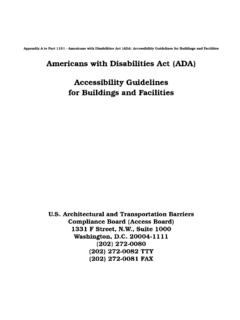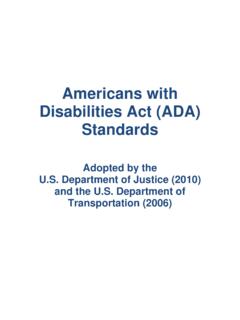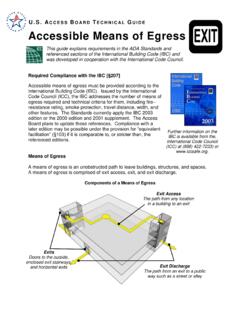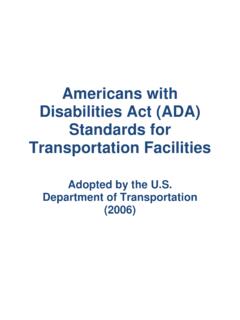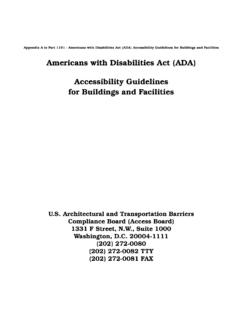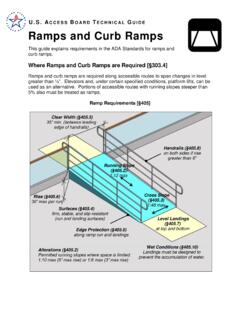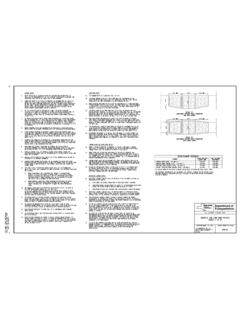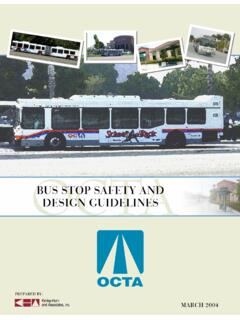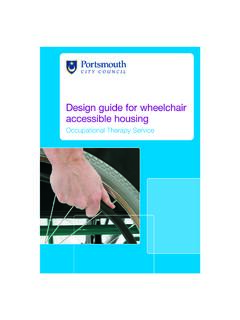Transcription of Public Rights-of-Way Accessibility Guidelines (with SUP ...
1 Public Rights-of-Way Accessibility Guidelines (with SUP)1 CHAPTER R1: APPLICATION AND ADMINISTRATIONR101 Purpose General. This document contains scoping and technical requirements to ensure that facilities for pedestrian circulation and use located in the Public right-of-way are readily accessible to and usable by pedestrians with disabilities. Compliance with this document is mandatory when required by regulations issued by federal agencies that include Accessibility standards for the design, construction, and alteration of pedestrian facilities in the Public right-of-way. Advisory General. Sections marked as advisory contain advisory information related to the preceding section. Advisory sections do not establish mandatory requirements. Some advisory sections reference related mandatory requirements to alert readers about those requirements. Effect on Existing Facilities. This document does not address existing facilities unless the facilities are included within the scope of an alteration undertaken at the discretion of a covered Effect on Existing Facilities.
2 The Department of Justice regulations implementing Title II of the Americans with Disabilities Act contain requirements for state and local governments regarding program Accessibility and existing facilities. See 28 CFR The Department of Transportation regulations implementing Section 504 of the Rehabilitation Act also contain requirements for recipients of federal financial assistance from the Department regarding compliance planning. See 49 CFR (c). R102 Equivalent Facilitation. The use of alternative designs, products, or technologies that result in substantially equivalent or greater Accessibility and usability than the requirements in this document is permitted. R103 Conventions Conventional Industry Tolerances. Dimensions are subject to conventional industry tolerances except where dimensions are stated as a range. Advisory Conventional Industry Tolerances. Conventional industry tolerances include tolerances for field conditions and tolerances that may be a necessary consequence of a particular manufacturing process.
3 Conventional industry tolerances do not apply to design work. Calculation of Percentages. Where the required number of elements or facilities to be provided is determined by calculations of ratios or percentages and remainders or fractions result, the next greater whole number of such elements or facilities shall be provided. Where the determination of the required size or dimension of an element or facility involves ratios or percentages, rounding down for values less than one half is permitted. Figure R103 Graphic Convention for FiguresPublic Rights-of-Way (with SUP) Accessibility Guidelines : CHAPTER R1: APPLICATION AND ADMINISTRATION2 Public Rights-of-Way Accessibility Guidelines (with SUP)3 Units of Measurement. Measurements are stated in metric and customary units. The values stated in each system (metric and customary units) may not be exact equivalents, and each system shall be used independently of the other.
4 Advisory Units of Measurement. Users should work entirely within one system of measurement, either metric or customary units. Combining values from the two systems may result in non-compliance. R104 Referenced Standards Incorporation by Reference. The specific editions of the standards listed in are incorporated by reference in this document and are part of the requirements to the prescribed extent of each such reference. The Director of the Federal Register has approved the standards for incorporation by reference in accordance with 5 552(a) and 1 CFR part 51. Copies of the referenced standards may be inspected at the Access Board, 1331 F Street, NW, Suite 1000, Washington, DC 20004; or at the National Archives and Records Administration (NARA). For information on the availability of the referenced standards at NARA, call (202) 741-6030, or go to: MUTCD. The portions of the Manual on Uniform Traffic Control Devices for Streets and Highways (MUTCD), 2009 Edition, that are incorporated by reference in this document consist of definitions (see ) and standard statements, as defined in section of the MUTCD (see R205, R209, and ).
5 Guidance, option, and support statements, as defined in section of the MUTCD, shall be used to assist in the interpretation of the standard statements. Where there are differences between this document and the referenced standards, this document applies. The MUTCD is available on the Federal Highway Administration website at Printed copies may be purchased from the American Association of State Highway and Transportation Officials, 444 N Capitol Street, NW, Washington, DC 20001 ( ). Advisory MUTCD. MUTCD definitions and standard statements are referenced in the following sections of this document: references definitions in section of the MUTCD; R205 references standard statements in sections , , , , , and of the MUTCD for providing alternate pedestrian access routes when a pedestrian circulation path is temporarily closed; R209 references standard statements in sections through of the MUTCD for accessible pedestrian signals and pedestrian pushbuttons; and references standard statements in section of the MUTCD for pedestrian signal phase timing.
6 R105 Definitions General. For the purpose of this document, the terms defined in have the indicated meaning. Public Rights-of-Way (with SUP) Accessibility Guidelines : CHAPTER R1: APPLICATION AND Terms Defined in Referenced Standards. Terms used in specific sections of the MUTCD that are incorporated by reference in this document shall have the meaning specified in section of the MUTCD (incorporated by reference, see ). In addition, the following terms shall have the meaning specified in section of the MUTCD (incorporated by reference, see ): highway, intersection, island, median, pedestrian, roundabout, sidewalk, splitter island, and Undefined Terms. The meaning of terms not specifically defined in , the referenced standards, or regulations issued by Federal agencies that adopt this document as Accessibility standards shall be as defined by collegiate dictionaries in the sense that the context implies.
7 Interchangeability. Words, terms, and phrases used in the singular include the plural and those used in the plural include the singular. Defined Terms. Accessible. Describes a facility in the Public right-of-way that complies with this document. Alteration. A change to a facility in the Public right-of-way that affects or could affect pedestrian access, circulation, or use. Alterations include, but are not limited to, resurfacing, rehabilitation, reconstruction, historic restoration, or changes or rearrangement of structural parts or elements of a facility. Blended Transition. A raised pedestrian street crossing, depressed corner, or similar connection between the pedestrian access route at the level of the sidewalk and the level of the pedestrian street crossing that has a grade of 5 percent or less. Cross Slope. The grade that is perpendicular to the direction of pedestrian Line. A line at the face of the curb that marks the transition between the curb and the gutter, street, or highway.
8 curb ramp . A ramp that cuts through or is built up to the curb . curb ramps can be perpendicular or parallel, or a combination of parallel and perpendicular ramps. Element. An architectural or mechanical component of a building, facility, space, site, or Public right-of-way. Facility. All or any portion of buildings, structures, improvements, elements, and pedestrian or vehicular routes located in the Public right-of-way. Grade Break. The line where two surface planes with different grades meet. Operable Part. A component of an element used to insert or withdraw objects, or to activate, deactivate, or adjust the element. Pedestrian Access Route. A continuous and unobstructed path of travel provided for pedestrians with disabilities within or coinciding with a pedestrian circulation path. Public Rights-of-Way Accessibility Guidelines (with SUP)5 Pedestrian Circulation Path. A prepared exterior or interior surface provided for pedestrian travel in the Public right-of-way.
9 Public Right-of-Way. Public land acquired for or dedicated to transportation purposes, or other land where there is a legally established right for use by the Public for transportation purposes. Qualified Historic Facility. A facility that is listed in or eligible for listing in the National Register of Historic Places, or designated as historic under an appropriate state or local law. Running Slope. The grade that is parallel to the direction of pedestrian travel. Shared Use Path. A multi-use path designed primarily for use by bicyclists and pedestrians, including pedestrians with disabilities, for transportation and recreation purposes. Shared use paths are physically separated from motor vehicle traffic by an open space or barrier, and are either within the highway right-of-way or within an independent Surface Discontinuities. Vertical differences in level between two adjacent surfaces. Public Rights-of-Way (with SUP) Accessibility Guidelines : CHAPTER R1: APPLICATION AND ADMINISTRATION6 Public Rights-of-Way Accessibility Guidelines (with SUP)7 CHAPTER R2: SCOPING REQUIREMENTSR201 Application Scope.
10 All newly constructed facilities, altered portions of existing facilities, and elements added to existing facilities for pedestrian circulation and use located in the Public right-of-way shall comply with the requirements in this document. Advisory Scope. The requirements in this document are to be applied to all areas of a facility within the scope of the project. Where multiple features of the same type are provided, such as on-street parking spaces, and a percentage of the features are required to be accessible, only the required number of features must comply with the technical requirements in this document and be connected to a pedestrian access route. Where elements are provided on a site that is a designated portion of a Public right-of-way, the elements are required to comply with the applicable requirements in this document instead of the requirements in the Americans with Disabilities Act Accessibility Guidelines for Buildings and Facilities and the Architectural Barriers Act Accessibility Guidelines (36 CFR part 1191).
